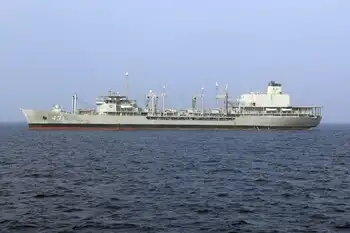
Biden officials signaled this week that the administration is concerned the ships could be carrying weapons bound for Caracas and warned that the United States would act to deter such a delivery. Satellite imagery of the ship from early May provided by Maxar Technologies shows seven fast-attack boats aboard its deck.
Pentagon spokesperson John Kirby noted that Venezuela purchased weapons from Iran over one year ago and warned that a new delivery "would be a provocative act and a threat to our partners in this hemisphere."
Kirby warned that the United States reserves the right “to take appropriate measures — in concert with our partners — to deter the delivery or transit of such weapons.”
It’s not clear what diplomatic efforts Washington has undertaken to deter the ships’ movement. State Department officials would not say if they’ve raised the issue with Iran in ongoing nuclear talks in Vienna. However, the department made clear in a statement that it's prepared to leverage “applicable authorities, including sanctions, against any actor that enables Iran’s ongoing provision of weapons to violent partners and proxies.”
An official with Iran’s mission to the United Nations did not immediately respond to a request for comment.
Some U.S. officials are surprised that the ships — the Sahand, its newest frigate; and the Makran, a previous oil tanker converted to a floating forward staging base — made it even this far and doubt that they are capable of completing the arduous journey across the Atlantic.
The ships are moving slowly, at just 8-10 knots, and officials believed at several points over the the previous week that they would turn back, the person said. It’s not clear whether the ships have the ability to replenish at sea, creating logistical challenges with undertaking such a long voyage.
However, if the ships stay on the current trajectory they will likely reach the east coast of South America in the next week or two, the defense official said.
Officials believe Iran chose to push on with the mission in part to save face after Iran’s largest warship, the Kharg, sank on Wednesday after catching fire in the Gulf of Oman near the Strait of Hormuz, the defense official said. Meanwhile, another suspicious blaze broke out at an oil refinery at the state-owned Tondgooyan Petrochemical Co. to the south of Tehran.
While the cause of the fires is not yet clear, in the past Israel has been suspected of carrying out attacks on Iranian infrastructure and military assets.
Iran has previously sent oil tankers into the Caribbean Sea to supply Venezuela, prompting warnings from the U.S. government. And in 2020, the United States confiscated four Iranian fuel shipments that had been bound for Venezuela in defiance of U.S. sanctions.
Experts cautioned that there is not much the United States will be able to do to deter the warships if they continue on their current trajectory. The ships are in international waters, and it's not clear they are breaking any laws.